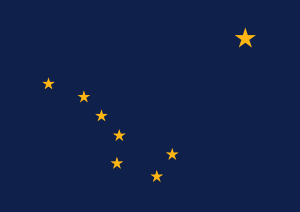Green Party of Alaska
| Green Party of Alaska | |
|---|---|
| Headquarters | P.O. Box 112947, Anchorage, Alaska 99551 |
| Ideology | Green politics |
| National affiliation | Green Party of the United States |
| Colors | Green |
| Website | |
| Alaska Greens | |
|
Politics of the United States Political parties Elections | |
| Part of a series on |
| Green politics |
|---|
.svg.png) |
|
Core topics |
|
The Green Party of Alaska is the state party organization for Alaska of the Green Party of the United States. Alaska was the first state to gain Green Party ballot access, in 1990, when Jim Sykes ran for governor. Sykes had previously filed a ballot access lawsuit, citing an earlier case, Vogler v. Miller.
Like the Alaska Libertarian Party, the Green Party organizes local affiliate groups by regions of the state rather than election districts. It is known for calling these groups bioregions. The organized bioregions of the GPAK include the Southcentral Bioregion (Anchorage area) and the Tanana-Yukon Bioregion (the Interior, around the Tanana and Yukon River areas).
The Green Party of Alaska has gained more than 10% of the votes in past presidential and congressional elections. The most notable example was in 2000, when Alaska voters gave presidential candidate Ralph Nader his highest state percentage. Nader made headlines when he carried the Girdwood precinct, located at the extreme southern end of Anchorage corporate limits. In 1996, the party's U.S. Senate nominee Jed Whittaker came in second, out-polling Democratic nominee Theresa Obermeyer, who had been disowned by her party.
The first election victory associated with the party was in 1991, when Kelley Weaverling was elected mayor of Cordova. Municipal elections in Alaska are nonpartisan, though Weaverling's association with the party was highly publicized at the time.
Issues
Energy policy
The Green Party of Alaska is the only political party in the state which is opposed to industrial oil development in the Arctic National Wildlife Refuge. Like other Green parties, it supports the development of alternative fuels and energy sources, in particular wind power and solar power.
GPAK also supports an all-Alaska gas line.
Health care
GPAK supports a national single-payer healthcare system.
History
Ballot status
The Green Party first gained ballot access in 1990, but lost its Recognized Political Party status in 2002. Ballot access was regained in 2003 based on a court order, lost again in 2005, and regained in February 2006 when Superior Court Judge Stephanie Joannides issued a preliminary injunction against the State of Alaska, preventing the state from denying access to the Green Party. On June 3, 2007 a lower Alaska state court upheld Alaska’s new definition of “political party” and the Green Party of Alaska was removed from the ballot. The judge wrote that she had to uphold the new definition of “political party”, because the Alaska Supreme Court had upheld the old definition of “political party” on November 17, 2006. In 2012, the Alaska Green party put forth a statewide petition, seeking status as a "limited political party" which would allow them to put names on the ballot for presidential and vice-presidential candidates. A total of 3,273 signatures is needed in Alaska to qualify as a limited political party. The Alaskan Greens submitted approximately 4,500 signatures to account for any nitpicking the two major parties would inevitably assign to this petition.
Elections
History of Green Party of Alaska candidates in statewide elections:
2006
- - Massie (Governor) (Note: this candidate did not receive the endorsement of the state party, but was a registered Green) Received .25% of the votes cast for governor
- - Ince (United States House of Representatives candidate) Received .78% of the votes cast for representative
2004
- - Sykes (United States Senate candidate) Received .99% of the votes cast for senator.
- - Feller (United States House of Representatives candidate) Received 3.81% of the votes cast for representative.
- - Cobb / LaMarche (President/Vice President candidates) Received .34% of the votes cast for president.
2002
- - Benson / Coburn (Governor / Lt. Governor candidates)
Received 1.26% of the votes cast for Governor. The party also had fewer registered voters than 3% of the votes cast for governor in the 2002 general election, thus losing its Recognized Political Party status. In 2003, based on an order granting a preliminary injunction by the Superior Court for the State of Alaska, the party was allowed to remain a recognized political party through the 2004 General Election.
- - Sykes (United States Senate candidate) Received 7.24% of the votes cast for senator, coming in third of five candidates.
- - DeForest (United States House of Representatives candidate) Received 6.34% of the votes cast for representative.
2000
- - Young (United States Senate candidate) Received 8.18% of the votes cast for senator, coming in third of five candidates.
- - Nader / LaDuke (President/Vice President candidates)
1998
- - Jacobsson / Milligan (Governor / Lt. Governor candidates) Received 3.01% of the votes cast for governor.
- - Grames (United States Senate candidate) Received 2.4% of the votes cast for senator.
1996
- - Whittaker (United States Senate candidate) Received 12.5% of the votes cast for senator, coming in second of three candidates.
- - Grames (United States House of Representatives candidate) Received 1.9% of the votes cast for representative.
- - Nader / LaDuke (President/Vice President)
1994 - Sykes / Lewis (Governor / Lt. Governor candidates) Received 4.1% of the votes cast for governor.
1992
- - Jordan (United States Senate) Received 8.4% of the votes cast for senator.
- - Milligan (United States House of Representatives) Received 4% of the votes cast for representative.
1990 - Sykes / Crumb (Governor / Lt. Governor candidates) Received 3.3% of votes cast for governor, attaining the State of Alaska's Recognized Political Party status.
Sources
External links
| ||||||||||||||||||||||||||||||||||||||||||
| |||||||||||||||||||||
